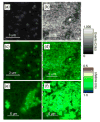Extremely sensitive dual imaging system in solid phantoms
- PMID: 27239085
- PMCID: PMC4882115
- DOI: 10.1117/12.2207908
Extremely sensitive dual imaging system in solid phantoms
Abstract
Herein we describe promising results from the combination of fluorescent lifetime imaging microscopy (FLIM) and diffusion reflection (DR) medical imaging techniques. Three different geometries of gold nanoparticles (GNPs) were prepared: spheres of 20nm diameter, rods (GNRs) of aspect ratio (AR) 2.5, and GNRs of AR 3.3. Each GNP geometry was then conjugated using PEG linkers estimated to be 10nm in length to each of 3 different fluorescent dyes: Fluorescein, Rhodamine B, and Sulforhodamine B. DR provided deep-volume measurements (up to 1cm) from within solid, tissue-imitating phantoms, indicating GNR presence corresponding to the light used by recording light scattered from the GNPs with increasing distance to a photodetector. FLIM imaged solutions as well as phantom surfaces, recording both the fluorescence lifetimes as well as the fluorescence intensities. Fluorescence quenching was observed for Fluorescein, while metal-enhanced fluorescence (MEF) was observed in Rhodamine B and Sulforhodamine B - the dyes with an absorption peak at a slightly longer wavelength than the GNP plasmon resonance peak. Our system is highly sensitive due to the increased intensity provided by MEF, and also because of the inherent sensitivity of both FLIM and DR. Together, these two modalities and MEF can provide a lot of meaningful information for molecular and functional imaging of biological samples.
Keywords: Gold nanoparticles; biomolecular imaging; diffusion reflection; fluorescence lifetime imaging; gold nanorods; metal enhanced fluorescence; noninvasive detection; tissue-imitating phantoms.
Figures





References
-
- El-Sayed MA. Some Interesting Properties of Metals Confined in Time and Nanometer Space of Different Shapes. Acc Chem Res. 2001;34(4):257–264. - PubMed
-
- Jain PK, Lee KS, El-Sayed IH, El-Sayed MA. Calculated Absorption and Scattering Properties of Gold Nanoparticles of Different Size, Shape, and Composition: Applications in Biological Imaging and Biomedicine. J Phys Chem B. 2006;110(14):7238–7248. - PubMed
Grants and funding
LinkOut - more resources
Full Text Sources
Other Literature Sources
Research Materials
